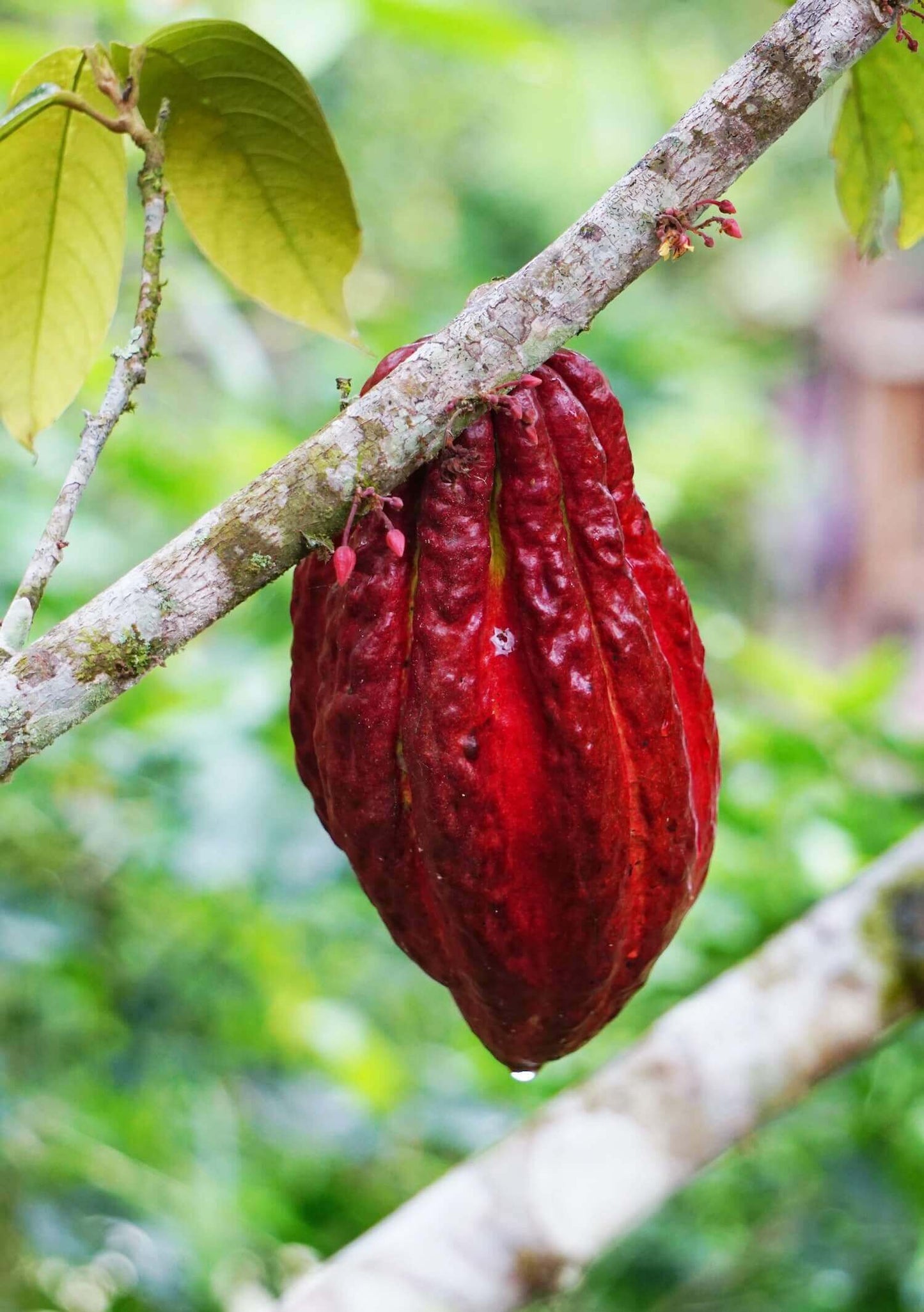
The story of ceremonial Cacao starts with the land. Cacao trees of certain strains must be grown in certain soils and only between certain latitudes. The delicacy of heirloom Cacao trees makes not only for their magnificent flavor and healing power but also for their exceeding rarity.
But does this delicate process end when the pods are pulled from the tree? The Cacao farmers would tell you: it’s only just begun.

Fermentation of Ceremonial Cacao
When the pods are harvested from the Cacao trees, they are split and the fruit inside is harvested. The seeds of Cacao, popularly known as Cacao beans, are surrounded by a white, juicy “flesh” or pulp. While sweet and surprisingly nutritious, this pulp is not the main event: the seed is.
The fermentation process is actually the fermentation of this pulp, which becomes inoculated with microorganisms in the environment. As the pulp is digested by these microorganisms, it falls away ands leaves just the seed exposed. Criollo-variety beans and most heirloom strains (as used in our Cacao) take anywhere from 3-5 days, while GMO strains can take up to 7 days. The farmers we work with (as is the case for most farms) use a wooden box. The beans are often covered with banana leaves within the box and are moved every 24-48 hours.
As the Cacao is rotated through these boxes, many chemical reactions occur while the interior heat of the Cacao mass rises and falls with each turning. The various chain reactions ultimately yield a soup of ethanol (alcohol, as develops during kombucha fermentation) and acetic acid. These compounds start to break down the cell walls in the bean, allowing enzymatic breakdown of the proteins and carbohydrates inside. The Cacao will now begin to develop the characteristic “chocolate” flavors that will further mature during roasting.
There are many farmers nowadays that skip the fermentation process of the bean, which is unfortunate because fermentation is a crucial part of processing Cacao. It activates nutrients, supports proper absorption, and brings out the delicate flavor of the Cacao bean. When this process of fermentation is skipped, the ungerminated bean won’t develop optimal Cacao flavor and certain key nutrient concentrations will not reach full potential. While reduction of some antioxidants occurs during fermentation (usually around 10%), it is a small trade-off for the much-reduced astringency of a fermented bean and the awakening of the secondary aroma characteristics of heirloom Cacao: notes of flowers, tropical fruits, and malt.

Drying Ceremonial Cacao
Once fermented, the beans are dried for about a week or two, depending on the weather. Our farmers use the traditional sun drying method, which modern science has shown best maintains the antioxidant integrity of the Cacao. As a rule, the slower the drying process, the less abrupt are the chemical reactions taking place inside the bean. Under higher-heat drying conditions (artificial dryers, heated chambers), unfavorable condensation reactions can occur within the bean, lowering its nutrient abundance. In climates too humid for natural drying (which Ecuador is not), the contained drying methods have been known to cause smokey off-flavors which are not desirable to most Cacao lovers.
Once dried, these beans can be roasted—the final step in producing Cacao nibs for consumption.
Roasting of Ceremonial Cacao
There has been a movement toward “raw” Cacao under the false assumption that skipping the vital roasting step is closer to traditional intention. We often hear about the potential loss of nutrients when Cacao is no longer “raw”, but the Mayans—and many other ancient civilizations who have worked with this sacred plant for thousands of years—see roasting as an important step in the process. According to Nana Marina from the Tz’utujil Maya nation, the aroma that comes from roasting the Cacao becomes an offering to the higher energies, the Gods, and the ancestors.
The Maya believe that the ceremony for Cacao begins in the process of roasting, and that one should be aware of how they are showing up while working with the sacred plant every step of the way, including the roasting. They believe that the intention and emotional state a person has when processing the Cacao is an active ingredient that directly impacts the Cacao. Needless to say, there is no ceremonial grade without roasting.
Importantly, roasting also affects the flavor, aroma, and nutrient content of the Cacao. During roasting, compounds that have developed during fermentation can interact and produce the recognizable “chocolate” flavor. These flavors are the result of a Maillard reaction between amino acids and sugars in the Cacao (this is what happens when you “brown” any food). These recognizable and delightful flavors do not happen without heat. In fact, without roasting, Cacao is highly astringent and bitter. Roasting allows these flavors to mellow considerably, and allows for the more delicate nuances of the bean to come out.
But not all roasting is equal. This is a key point to make when considering the effect of roasting on the nutritional value of the bean. Generally, a lower roasting temperature will better maintain the nutritional integrity of the Cacao bean. While there are some antioxidants that are destroyed by the heat reactions in roasting and some that are actually created, the best balance by ORAC measures (oxygen radical absorbency capacity—more about that here [link to Lab report 2] is maintained through low-heat, relatively short roasting periods. Traditional fire-roasting methods generally maintain this low-heat preference, although the skill and experience of the roaster is paramount. Controlling the fire, the aroma, and sensing when the Cacao is perfect is central to the sacred intention behind ceremonial Cacao. To prepare the Cacao correctly is to respect it.
Respecting the Process
In our new digital world of endless optimization, tinkering, and revision of ancient wisdom, it can be tempting to try to engineer something to be just that little bit better. But, as we’ve tried to show here, modern science can confirm what centuries of continuous process already know: traditional methods are often the best methods. This is certainly true for Cacao.
Ceremonial grade Cacao is crafted with the intention of thousands of years of sacred practice. Growing, fermenting, drying, and roasting are integral to that practice. With respect for those who have come before and for those that are doing the work with us now, we are honored to continue the process.
